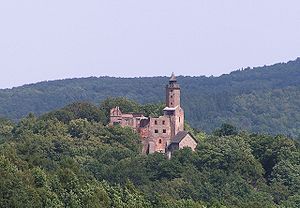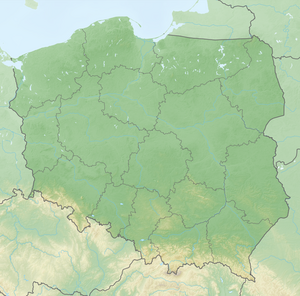Grodno Castle
| Grodno Castle | ||
|---|---|---|
|
Grodno Castle, view from the southwest |
||
| Alternative name (s): | Kynsburg | |
| Creation time : | 1300 | |
| Castle type : | Summit castle | |
| Conservation status: | ruin | |
| Place: | Zagórze Śląskie | |
| Geographical location | 50 ° 44 '59.4 " N , 16 ° 24' 39.3" E | |
| Height: | 485 m npm | |
|
|
||
The Grodno Castle (German: Kynsburg ) northeast of the village of Zagórze Śląskie (Kynau) belongs to the Powiat Wałbrzyski ( Waldenburg ) in the Lower Silesian Voivodeship in Poland. It lies on a narrow area on a rocky ledge and is surrounded in the south and east by a deep gorge of the Weistritz ( Bystrzyca ). The castle consists of a so-called Lower Castle and an Upper Castle . The villages of Kynau , Dittmannsdorf , Reußendorf , Seifersdorf, Hausdorf, Tannhausen, Jauernig and Schenkendorf belonged to the castle district .
history
The Kynsburg was built by Bolko I at the end of the 13th century to secure the border with Bohemia . It was initially a ducal fiefdom owned by Burgrave Kilian von Haugwitz . He was followed by the burgraves Peczko Eycke and Schoff . After the marriage of Princess Anna of Schweidnitz with the Bohemian King and later Emperor Charles IV , the castle lost its strategic importance.
In 1368 the Kynsburg fell together with the Duchy of Schweidnitz to the Crown of Bohemia and was administered as a royal pledge by the royal governors. These were, among others, the gentlemen from Reibnitz , von Mühlbach and von Czettritz . Herrmann von Czettritz († 1454) sympathized with the Hussites and was therefore able to prevent their attacks. In 1535 the castle came to the Counts of Hochberg ( Hoberg; Hohberg ) on Fürstenstein , from 1567 it was owned by the Lords of Logau . It was owned by Prince Michael of Wallachia from 1596–1601 and, from 1607, Count Johann Georg von Hohenzollern-Sigmaringen , who lived on the Kynsburg but left it because of the destruction in the Thirty Years' War . His descendants or the Rochow sideline owned the Kynsburg until 1679. After a lightning strike in 1686, the keep was given an octagonal tower. In 1689 a fire destroyed large parts of the castle.
After numerous changes of ownership, the Lords of Liers followed in 1754, who moved their residence to Dittmannsdorf in 1774 , so that the castle was then uninhabited. In 1789 the south wing partially collapsed. In 1819 the castle and the associated castle district were foreclosed by auction. In order to save the castle from demolition, it was acquired by the Wroclaw archaeologist Johann Gustav Gottlieb Büsching in 1823 . After his death in 1829 and further changes of ownership, the castle and the castle district passed to the Lords of Zedlitz-Neukirch in 1855 . In 1868 they initiated renovation and conservation measures as well as the reconstruction of the sgraffiti by the decorative painter Emil Noellner. A museum was set up in 1903–1904, and modernization measures were carried out in 1929–1945.
After the transition to Poland in 1945, the Kynsburg was renamed Zamek Chojny, later Zamek Grodno. Numerous exhibits and valuable furniture were subsequently destroyed. In 1964 the roofs were re-covered and a year later a museum was set up again.
literature
- Karl August Müller: Patriotic images, in a history and description of the old castle festivals and knight castles of Prussia. Glogau 1837, pp. 33-52.
- Georg Dehio : Handbook of Art Monuments in Poland. Silesia . Deutscher Kunstverlag, Munich, Berlin 2005, ISBN 3-422-03109-X , pp. 1166–1167.
- Hugo Weczerka (Hrsg.): Handbook of the historical places . Volume: Silesia (= Kröner's pocket edition . Volume 316). Kröner, Stuttgart 1977, ISBN 3-520-31601-3 , pp. 257-259.
Web links
- Castle website (Polish)



